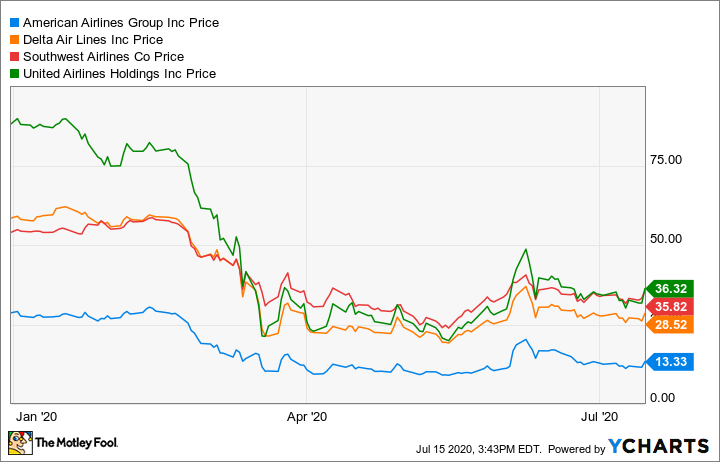## Navigating the Turbulence: A Comprehensive Guide to Investing in Airline Stocks
**Introduction**
The aviation industry is a complex and cyclical one, with airlines facing constant challenges from economic headwinds, geopolitical uncertainties, and operational complexities. Despite these hurdles, airline stocks can offer attractive investment opportunities for those who understand the industry’s unique dynamics and potential risks. This comprehensive guide will delve into the key factors to consider when evaluating and investing in airline stocks, providing investors with a roadmap for making informed decisions.
### Understanding the Airline Industry Landscape
**1. Industry Dynamics**
The airline industry is characterized by:
* **High fixed costs:** Airlines have significant expenses, such as aircraft purchases or leases, maintenance, and fuel, which remain relatively constant regardless of passenger volume.
* **Price-sensitive demand:** Air travel is a discretionary expense for many consumers, making demand sensitive to economic conditions and price fluctuations.
* **Network effects:** Airlines benefit from network effects, where connecting more cities and flights creates a competitive advantage.
* **Government regulations:** The industry is heavily regulated by governments, impacting everything from safety standards to route approvals.
**2. Factors Affecting Airline Performance**
Several factors can influence an airline’s financial performance:
* **Economic conditions:** Economic growth, unemployment rates, and consumer confidence affect air travel demand.
* **Fuel prices:** Jet fuel is a major expense for airlines, so fluctuations in oil prices can impact profitability.
* **Competition:** Intense competition from rival carriers and low-cost airlines keeps pricing pressure on legacy carriers.
* **Operational efficiency:** Airlines strive to improve efficiency through technology, cost-cutting measures, and optimal fleet utilization.
* **Political and geopolitical events:** War, terrorism, and political instability can disrupt travel patterns and impact airline revenue.
### Evaluating Airline Stocks: Key Metrics
**1. Financial Analysis**
* **Revenue:** Total income from passenger bookings, cargo operations, and other sources.
* **Net income:** Profit after expenses, including operating costs, interest payments, and taxes.
* **Earnings per share (EPS):** Net income divided by the number of outstanding shares.
* **Profit margin:** Net income as a percentage of revenue, indicating profitability.
* **Debt-to-equity ratio:** Debt obligations compared to equity, assessing financial leverage.
**2. Operational Metrics**
* **Load factor:** Percentage of seats filled on flights, indicating capacity utilization.
* **Yield:** Average revenue per passenger mile, measuring fare pricing effectiveness.
* **On-time performance:** Reliability and efficiency of flight operations.
* **Customer satisfaction:** Metrics measuring passenger experience and loyalty.
### Investing Strategies for Airline Stocks
**1. Cyclical Investing**
* Invest in airlines during economic expansions when air travel demand is high.
* Sell or reduce positions during economic downturns when demand diminishes.
**2. Value Investing**
* Focus on airlines with low valuations relative to earnings and assets.
* Look for companies with strong financial positions and growth potential.
**3. Growth Investing**
* Target airlines with a track record of consistent revenue and earnings growth.
* Consider emerging carriers with expansion plans and market share gains.
**4. Special Situations**
* Seek opportunities in mergers and acquisitions, bankruptcies, or government bailouts.
* Understand the potential risks and rewards associated with these situations.
### Risks and Considerations
**1. Economic Headwinds**
* Recessions and economic downturns can significantly reduce air travel demand.
**2. Fuel Prices**
* Jet fuel prices can fluctuate widely, impacting airlines’ operating costs and profitability.
**3. Competition**
* Intense competition from low-cost carriers and new entrants can erode market share and margins.
**4. Government Intervention**
* Government regulations and policies can affect airline operations, pricing, and profitability.
**5. Operational Challenges**
* Delays, cancellations, and safety issues can negatively impact customer satisfaction and brand reputation.
**6. Geopolitical Risks**
* War, terrorism, and natural disasters can disrupt travel plans and impact airline revenue.
### Conclusion
Investing in airline stocks requires a thorough understanding of the industry dynamics, careful analysis of key metrics, and thoughtful consideration of risks and potential rewards. By navigating the turbulence of the airline industry, investors can identify opportunities to generate attractive returns while mitigating downside risks. Remember to conduct thorough research, diversify your portfolio, and remain vigilant in monitoring the evolving landscape of the airline industry.
